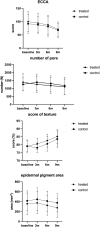Efficacy of a Combination Treatment of Ablative Fractional Carbon Dioxide Laser Therapy and Recombinant Human Epidermal Growth Factor for Atrophic Acne Scars
- PMID: 39212099
- PMCID: PMC11626307
- DOI: 10.1111/jocd.16552
Efficacy of a Combination Treatment of Ablative Fractional Carbon Dioxide Laser Therapy and Recombinant Human Epidermal Growth Factor for Atrophic Acne Scars
Abstract
Background: Atrophic acne scars (AAS) are disfiguring and permanent changes caused by inflammatory acne. Fractional carbon dioxide is a common ablative device used to treat this condition. However, issues such as unclear effectiveness, frequent treatments, and potential side effects exist. In recent years, recombinant human epidermal growth factor (rhEGF) has also been frequently reported for its application in the treatment of acne scars.
Objective: To explore the potential synergistic effect of fractional carbon dioxide laser combined with rhEGF in AAS treatment.
Methods: We enrolled 15 patients with AAS. They received fractional carbon dioxide laser treatment and were then randomly assigned to receive either rhEGF or a placebo on one side of the face. The procedure was repeated three times, and the results were evaluated using the échelle d'évaluation clinique des cicatrices d'acné (ECCA) score and analyzed using the CBS camera system, 3D analysis (3DMD). Reflectance confocal microscopy (RCM) examination was also conducted.
Results: Both sides exhibited significant improvement in the appearance of the acne scars after treatment, as confirmed by the ECCA score, 3DMD data, and CBS texture score. On the rhEGF-treated side, the pore number and epidermal pigment area significantly improved as compared to the control side, whereas no significant differences were observed in the other data. Under RCM, a significant increase in epidermal thickness and appearance of reticular collagen fibers in the dermal layer after treatment was observed.
Conclusion: Compared to the sole use of laser, the combination of fractional carbon dioxide laser and rhEGF does not significantly enhance scar therapeutic effects. However, it does shorten the recovery period after laser treatment and improves the pore appearance.
Keywords: atrophic acne scar; fractional carbon dioxide laser; recombinant human epidermal growth factor.
© 2024 The Author(s). Journal of Cosmetic Dermatology published by Wiley Periodicals LLC.
Conflict of interest statement
The authors declare no conflicts of interest.
Figures





Similar articles
-
[Clinical effects of fractional carbon dioxide laser combined with minimally invasive scar release in the treatment of post-acne atrophic scars].Zhonghua Shao Shang Yu Chuang Mian Xiu Fu Za Zhi. 2023 Jan 20;39(1):53-58. doi: 10.3760/cma.j.cn501225-20220616-00238. Zhonghua Shao Shang Yu Chuang Mian Xiu Fu Za Zhi. 2023. PMID: 36740426 Free PMC article. Chinese.
-
Combination treatment with 30% salicylic acid and fractional CO2 laser for acne scars: A 20-week prospective, randomized, split-face study.Dermatol Ther. 2022 Sep;35(9):e15693. doi: 10.1111/dth.15693. Epub 2022 Jul 22. Dermatol Ther. 2022. PMID: 35791845 Clinical Trial.
-
Comparison of Non-insulated Microneedle Fractional Radiofrequency and Ablative Fractional Carbon Dioxide Laser for the Treatment of Facial Atrophic Acne Scarring: A Pilot Randomized Split-face Clinical Study.Acta Derm Venereol. 2025 Jun 26;105:adv43611. doi: 10.2340/actadv.v105.43611. Acta Derm Venereol. 2025. PMID: 40568948 Free PMC article. Clinical Trial.
-
Ablative fractional carbon dioxide laser combined with autologous platelet-rich plasma in the treatment of atrophic acne scars: A systematic review and meta-analysis.Dermatol Ther. 2022 Dec;35(12):e15888. doi: 10.1111/dth.15888. Epub 2022 Oct 14. Dermatol Ther. 2022. PMID: 36183145
-
Efficacy of Autologous Platelet-Rich Plasma Combined With Ablative Fractional Carbon Dioxide Laser for Acne Scars: A Systematic Review and Meta-Analysis.Aesthet Surg J. 2019 Jun 21;39(7):NP279-NP287. doi: 10.1093/asj/sjz048. Aesthet Surg J. 2019. PMID: 30809666
References
-
- Kim J. M., Choo J. E., Lee H. J., Kim K. N., and Chang S. E., “Epidermal Growth Factor Attenuated the Expression of Inflammatory Cytokines in Human Epidermal Keratinocyte Exposed to Propionibacterium Acnes,” Annals of Dermatology 30, no. 1 (2018): 54–63, 10.5021/ad.2018.30.1.54. - DOI - PMC - PubMed
Publication types
MeSH terms
Substances
Grants and funding
LinkOut - more resources
Full Text Sources
Medical

